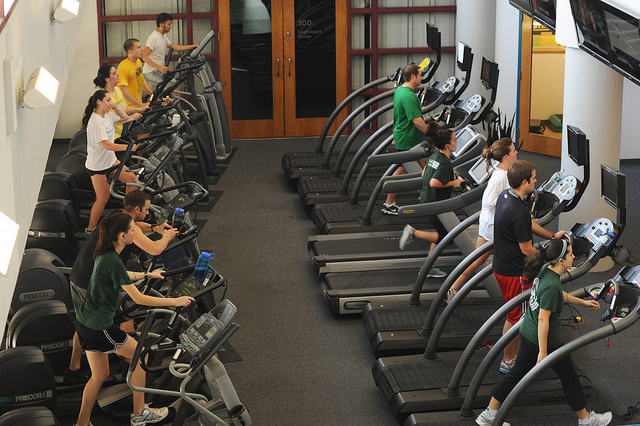Why is working out so painful?
There’s a reason those New Year’s resolutions to go to the gym more often are so hard to keep
Katherine Ellen Foley • January 19, 2015

Aerobic activity like using the elliptical or running on a treadmill may make you sore for the next few days. [Image credit: Flickr user Tulane Public Relations]
During the month of January, the gym is place to be. According to the New York Times, new gym and health club memberships may as much as double during the first month of every year when many resolve to get fit or lose weight. But Time Magazine reported that by mid-February, gym attendance is back to its usual levels; in other words, all those resolutions have been put on the back burner.
Exercise is known to have all sorts of benefits: According to the Mayo Clinic, exercise can increase your energy and bone density, better your mood, help you sleep and even improve your sex life. But as any athlete will tell you, there’s a reason coaches like to use the phrase, “No pain, no gain!” Whether you’re taking your first pair of running shoes out of the box or powering through your fourth marathon, chances are your workouts will cause you some discomfort. It seems a little counterintuitive that an activity that benefits us could come with unwanted side effects. But there’s a reason for the struggle: Our bodies are learning to operate under a little bit of strain that will ultimately benefit them.
All cells in our bodies need oxygen to convert sugar into ATP, our bodies’ main source of energy. But our muscles need extra oxygen when we’re stretching and contracting them during exercise. Ever find yourself breathing more heavily with a faster heart rate after walking up a flight of stairs? This is because your muscles in your arms and legs signal to your heart and lungs that they need more oxygen to make more energy. Automatically, you start breathing more quickly to get more of this precious gas (which only makes up about 20 percent of the air).
Your heart, another muscle, takes the oxygen from your lungs and supplies it to your blood. As the heart keeps pumping, oxygen-enriched blood spreads through the arteries and veins in your body to reach your muscles (as well as all your other organs and tissues). This is highway of vessels called your cardiovascular system, and as you exercise more and more regularly, it becomes more efficient at delivering the goods.
Walking, running, swimming, and other exercises that raise your heart rate and are sustainable for more than a few minutes are all what scientists call aerobic activity, and what gym-goers call cardio. The Centers for Disease Control and Prevention recommends that you get 75 minutes of cardio three to five days a week to keep your heart and lungs healthy.
Sometimes, though, even the oxygen circulating isn’t enough to get your muscles to do what you want them to. When you’re lifting weights or doing movements like lunging, squatting or pushups, your cardiovascular system doesn’t have time to deliver oxygen to your muscles to make ATP. Instead, they use sugar to create a substance called lactate, or lactic acid, in a process called anaerobic activity (literally, without air). Anaerobic activity isn’t sustainable for very long, and it’s not as efficient as aerobic exercise. Furthermore, lactic acid is responsible for creating that stinging sensation in your muscles when you’re “feeling the burn.” While it may not be pleasant, lactic acid is our body’s way of protecting itself from damaging muscles. Theoretically, the pain is a signal to us that we need to ease up on the exercise so we don’t overexert them. Once you come down from that anaerobic level, the body begins to get rid of any residual lactic acid and your muscles go back to their preferred aerobic activity.
But then there’s the after-effect of working out. While many feel refreshed and less-stressed after hitting the gym, your muscles may feel tender the next day. This is called delayed onset muscle soreness, or DOMS, and it can last for up to 72 hours. Scientists used to think that this was because of the lactic acid buildup, but it’s actually a side effect of repairing tiny tears in your muscles. Rebuilding muscle tissue is actually what helps muscles grow, and sometimes the second day after intense exercise may feel worse than the first.
Muscle soreness isn’t particularly dangerous — the pain may even subside when you start exercising again, although it may return once more during the recovery. But if you’re having trouble getting out of bed the morning after a tough workout, you should probably give your body a break for the day to let it recover, and make sure to eat plenty of protein — foods like meat, eggs or soy — to help your muscles build themselves up again.
It’s hard to say whether muscle pain is the reason so many New Years’ resolvers quit after the first month or so. It could be that people don’t have the same amount of time they did during the holidays, or that they just haven’t found an exercise that’s fun for them. Of course, there’s no reason exercise has to be limited to the gym: Walking or running outside are excellent workouts, and there are many effective routines you can do at home without taking up too much time. So, whether you decide to join a gym or not, push through the pain! It’s all just a part of biology.